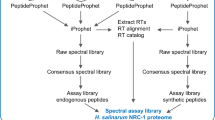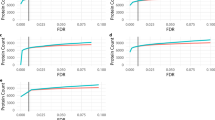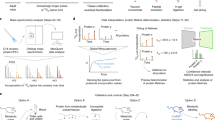Abstract
We describe a protein quantification method called neutron encoding that exploits the subtle mass differences caused by nuclear binding energy variation in stable isotopes. These mass differences are synthetically encoded into amino acids and incorporated into yeast and mouse proteins via metabolic labeling. Mass spectrometry analysis with high mass resolution (>200,000) reveals the isotopologue-embedded peptide signals, permitting quantification. Neutron encoding will enable highly multiplexed proteome analysis with excellent dynamic range and accuracy.
This is a preview of subscription content, access via your institution
Access options
Subscribe to this journal
Receive 12 print issues and online access
$259.00 per year
only $21.58 per issue
Buy this article
- Purchase on Springer Link
- Instant access to full article PDF
Prices may be subject to local taxes which are calculated during checkout


Similar content being viewed by others
References
Domon, B. & Aebersold, R. Nat. Biotechnol. 28, 710–721 (2010).
Altelaar, A.F.M. et al. J. Proteomics published online, http://dx.doi.org/10.1016/j.jprot.2012.10.009 (18 October 2012).
Ong, S.E. et al. Mol. Cell Proteomics 1, 376–386 (2002).
Oda, Y., Huang, K., Cross, F.R., Cowburn, D. & Chait, B.T. Proc. Natl. Acad. Sci. USA 96, 6591–6596 (1999).
Gygi, S.P. et al. Nat. Biotechnol. 17, 994–999 (1999).
Thompson, A. et al. Anal. Chem. 75, 1895–1904 (2003).
Ross, P.L. et al. Mol. Cell Proteomics 3, 1154–1169 (2004).
Hsu, J.-L., Huang, S.-Y., Chow, N.-H. & Chen, S.-H. Anal. Chem. 75, 6843–6852 (2003).
Choe, L. et al. Proteomics 7, 3651–3660 (2007).
McAlister, G.C. et al. Anal. Chem. 84, 7469–7478 (2012).
Werner, T. et al. Anal. Chem. 84, 7188–7194 (2012).
Ow, S.Y. et al. J. Proteome Res. 8, 5347–5355 (2009).
Wenger, C.D. et al. Nat. Methods 8, 933–935 (2011).
Grimsrud, P.A. et al. Cell Metab. 16, 672–683 (2012).
Sleno, L. J. Mass Spectrom. 47, 226–236 (2012).
Denisov, E., Damoc, E., Lange, O. & Makarov, A. Int. J. Mass Spectrom. 325–327, 80–85 (2012).
Xian, F., Hendrickson, C.L., Blakney, G.T., Beu, S.C. & Marshall, A.G. Anal. Chem. 82, 8807–8812 (2010).
Schaub, T.M. et al. Anal. Chem. 80, 3985–3990 (2008).
Michalski, A. et al. Mol. Cell Proteomics 11, O111.013698 (2012).
Cui, Z. et al. Proteomics 9, 1274–1292 (2009).
Elias, J.E. & Gygi, S.P. Nat. Methods 4, 207–214 (2007).
Geer, L.Y. et al. J. Proteome Res. 3, 958–964 (2004).
Nesvizhskii, A.I. & Aebersold, R. Mol. Cell Proteomics 4, 1419–1440 (2005).
Wenger, C.D., Phanstiel, D.H., Lee, M.V., Bailey, D.J. & Coon, J.J. Proteomics 11, 1064–1074 (2011).
Acknowledgements
We thank A.J. Bureta for help with figure illustrations, R. Manis for critical proofreading and A. Gasch (University of Wisconsin-Madison) for assistance in the culturing of yeast cells. This work was supported by US National Institutes of Health (NIH) grant R01 GM080148 to J.J.C. A.E.M. gratefully acknowledges support from an NIH-funded Genomic Sciences Training Program (5T32HG002760). This work was also supported by a Searle Scholars Award and Shaw Scientist award to D.J.P. and a National Science Foundation graduate fellowship and NIH training grant 5T32GM007215-37 to A.J.S.
Author information
Authors and Affiliations
Contributions
A.S.H. and A.E.M. designed and performed research, analyzed data and wrote the paper; D.J.B. performed theoretical calculations; M.S.W. analyzed data; E.R.S. designed research studies; D.J.P. and A.J.S. designed and prepared the murine model system; J.J.C. designed research studies and wrote the paper.
Corresponding author
Ethics declarations
Competing interests
A.S.H. and J.J.C. are co-inventors on a patent application (US 13/660677) related in part to the material presented here.
Supplementary information
Supplementary Text and Figures
Supplementary Figures 1–7 (PDF 2012 kb)
Supplementary Table 1
Myogenic differentiation protein quantitation (XLSX 219 kb)
Rights and permissions
About this article
Cite this article
Hebert, A., Merrill, A., Bailey, D. et al. Neutron-encoded mass signatures for multiplexed proteome quantification. Nat Methods 10, 332–334 (2013). https://doi.org/10.1038/nmeth.2378
Received:
Accepted:
Published:
Issue Date:
DOI: https://doi.org/10.1038/nmeth.2378
This article is cited by
-
Defining the carrier proteome limit for single-cell proteomics
Nature Methods (2021)
-
TMTpro reagents: a set of isobaric labeling mass tags enables simultaneous proteome-wide measurements across 16 samples
Nature Methods (2020)
-
Multiplexed proteome analysis with neutron-encoded stable isotope labeling in cells and mice
Nature Protocols (2018)
-
pSILAC mass spectrometry reveals ZFP91 as IMiD-dependent substrate of the CRL4CRBN ubiquitin ligase
Nature Communications (2017)
-
Multidimensional proteomics for cell biology
Nature Reviews Molecular Cell Biology (2015)



